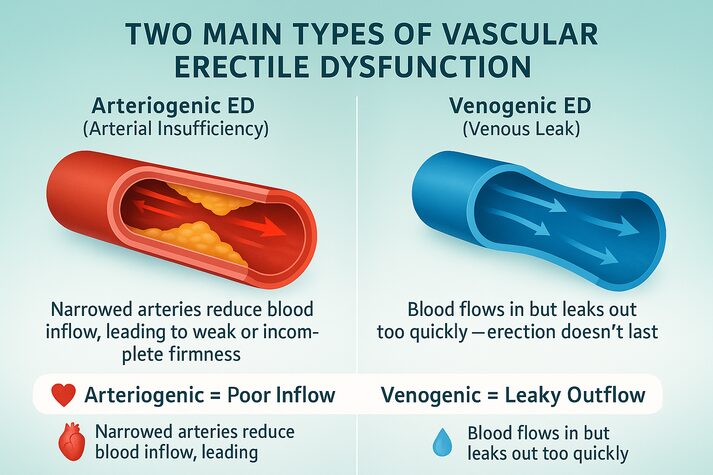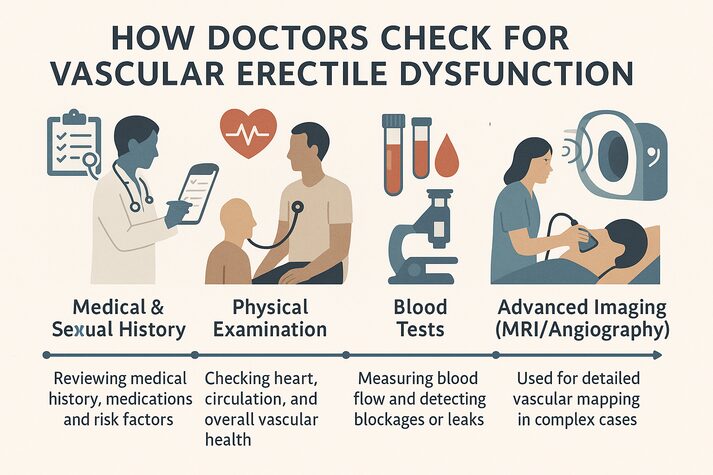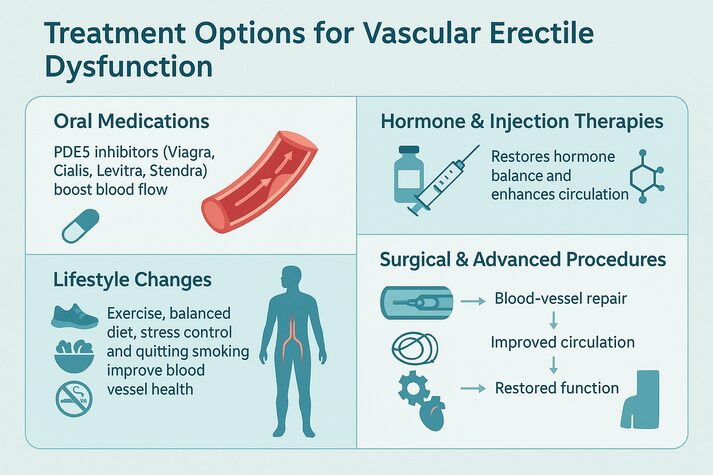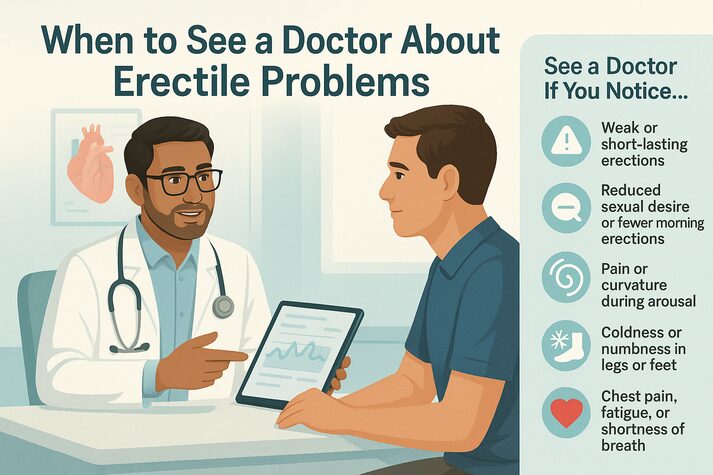Understanding Vascular Erectile Dysfunction: Causes and Treatments

Vascular erectile dysfunction (ED) happens when poor blood flow or leaky veins make it hard to get or keep an erection. It’s often linked to heart disease, diabetes, high blood pressure, or high cholesterol, since the same blood vessels that affect the heart also affect the penis. Symptoms usually start gradually with weaker erections or fewer morning erections. Vascular ED can also be an early warning sign of heart disease, appearing years before other symptoms. The condition is treatable. A doctor can identify the cause through simple tests and recommend medications, lifestyle changes, or other treatments. If erection issues keep happening, see a doctor early, as it can help restore sexual function and prevent serious heart problems later.
Vascular erectile dysfunction (ED) is one of the most common types of erectile problems in men. During arousal, the penis needs steady blood flow to stay firm. When that flow is weak or when blood leaks out too soon, erections become hard to achieve or maintain. This is vascular erectile dysfunction. It happens due to problems in the blood vessels or heart. Simply put, if your arteries aren’t healthy, your erections can suffer.
In this article, we’ll explore what vascular erectile dysfunction is, why it happens, common symptoms, and the best ways to treat it.
What is Vasculogenic Erectile Dysfunction?
Vasculogenic or vascular erectile dysfunction is a type of ED that happens when there’s not enough blood flow to the penis or when blood leaks out too quickly during an erection.
Doctors classify ED as either psychological or physical. Vascular erectile dysfunction is a physical type and the most common, making up about 75% of such cases. [1]
Under normal conditions, when a man becomes sexually aroused, the brain sends signals that cause arteries in the penis to relax and widen. This allows blood to flow into the penis. As these chambers fill with blood, the penis becomes firm and erect. Tiny veins in the penis then close to keep the blood trapped, helping maintain the erection until sexual activity ends.
A lack of good blood flow causes vascular ED. Let’s look at the different types of vascular ED.
Types of Vasculogenic Erectile Dysfunction
There are two main forms of vascular erectile dysfunction:
1. Arteriogenic ED (Arterial Insufficiency):
This happens when arteries that carry blood to the penis are narrowed or blocked. We will look at the causes in detail later. This type of ED is called arteriogenic erectile dysfunction.
2. Venogenic ED (Venous Leak)
In this type, a normal amount of blood required for a healthy erection enters the penis, but it is drained out too quickly. This leads to short-lived erections. This type of ED is called venogenic erectile dysfunction.
Several risk factors and medical conditions can cause or worsen vascular erectile dysfunction.

Causes of Vascular Erectile Dysfunction
Medical Conditions:
1. Atherosclerosis (Clogged Arteries)
- Atherosclerosis is one of the most common causes of vascular erectile dysfunction.[2]
- It happens when fat and cholesterol build up inside the arteries, forming hard plaque that narrows them and restricts blood flow.
2. Peripheral Artery Disease (PAD)
- PAD affects the arteries that carry blood to the legs, feet, and lower body.
- The reduced circulation that causes leg cramps, cold feet, and slow healing can also limit blood flow to the penis, leading to ED. [3]
3. Coronary Artery Disease (CAD)
- CAD happens when plaque builds up in the arteries that supply blood to the heart, reducing circulation and oxygen delivery.
- The same vascular damage can affect the smaller penile arteries, which are more sensitive.[4]
4. Diabetes
- When blood sugar levels stay high for a long time, it damages both nerves and blood vessels throughout the body, including those that supply the penis. [5]
- This makes the penile arteries less elastic and restricts blood flow during arousal.
- It also causes diabetic neuropathy, which disrupts the signals between the brain and the penis, and lowers nitric oxide production, a key chemical needed to relax blood vessels and achieve a firm erection.
5. High Blood Pressure and High Cholesterol
- When blood pressure is constantly high, the pressure on artery walls causes small tears. The body tries to heal these by forming scar tissue, which makes the vessels thicker. This reduces the arteries’ ability to expand during sexual arousal, meaning less blood reaches the erectile tissue.[6]
- Meanwhile, high cholesterol contributes to plaque buildup inside arteries, as mentioned earlier (atherosclerosis).
6. Peyronie’s Disease
- Peyronie’s disease can sometimes cause ED. It is a condition where scar tissue (plaques) forms inside the penis, just beneath the skin.
- This scar tissue causes the penis to bend or curve during erection, which can make intercourse painful or difficult. The scar tissue can also block blood from flowing in the arteries.
If you’re struggling with ED and also have high blood pressure, high cholesterol, or diabetes, it’s essential to get your heart and circulation checked early.
Lifestyle Risk Factors
- Smoking tobacco can cause ED as it damages the inner lining of blood vessels and reduces the production of nitric oxide. Long-term smokers are up to 50% more likely to develop vascular erectile dysfunction than non-smokers.[7]
- Excessive alcohol can depress the central nervous system and reduce sexual response.
- Lack of exercise weakens the heart and blood vessels, allowing fat buildup and reducing oxygen delivery to the penis.
- An unhealthy diet that’s heavy in refined carbs or fried foods promotes inflammation and insulin resistance, increasing the risk of vascular ED.
- Obesity contributes to insulin resistance, high cholesterol, and high blood pressure, all of which cause ED. In addition, overweight men often have lower testosterone levels, which can reduce sexual desire (libido) and energy levels.
- Chronic stress triggers the release of stress hormones that narrow blood vessels and interfere with sexual arousal.
Medications:
Certain prescription medications can sometimes cause ED as a side effect:
- Blood pressure medicine: such as older beta-blockers (like propranolol) and diuretics.
- Antidepressants: SSRIs, SNRIs like venlafaxine.

Vascular Erectile Dysfunction Symptoms
Recognizing vascular erectile dysfunction symptoms early can help prevent further complications. The main signs include:
1. Difficulty Getting an Erection
The most common early sign is finding it harder to achieve an erection, even when you feel aroused.
2. Trouble Maintaining an Erection
Some men can get an erection but lose it quickly during intercourse. This often suggests a venous leak.
3. Reduced Firmness or Strength of Erections
You may notice erections that feel softer or don’t last as long as they used to. This indicates reduced blood pressure inside the penile chambers, often due to narrowed arteries.
4. Fewer Morning or Spontaneous Erections
Healthy men typically experience morning erections. A decline in these spontaneous erections can be an early marker of vasculogenic ED.
5. Decreased Sexual Desire
While blood flow issues are physical, the frustration of repeated erection problems can affect sexual feelings, confidence, and even lead to mental health concerns such as stress or anxiety.
6. Heart-Related Symptoms
Research shows ED can appear 3–5 years before a heart attack or stroke. [8] Because vascular erectile dysfunction is linked to cardiovascular problems, you might also notice signs of poor circulation, like:
- Shortness of breath during mild activity
- Chest pain or tightness, especially during physical exertion or stress
- Fatigue or low energy levels
- Cold hands and feet
- Rapid heartbeat (palpitations)
- Dizziness or lightheadedness
Healthy erections rely on healthy blood vessels. When you take care of your heart, you’re also taking care of your sexual health.
How Do Doctors Find Out the Cause of Vascular ED?
A urologist or sexual health specialist usually begins with:
- Medical and sexual history review to identify possible risk factors
- Physical examination of the genital area and cardiovascular system
- Blood tests to check cholesterol, blood sugar, and testosterone levels
- Penile Doppler ultrasound to measure blood flow and detect blockages or venous leaks
Sometimes, advanced imaging such as selective penile angiography or MRI angiography may be done for complex cases.

Vascular Erectile Dysfunction Treatment
Vascular erectile dysfunction is often treatable and sometimes reversible, especially when underlying causes are managed early. The treatments include:
1. Oral Medications
Drugs like Viagra (sildenafil), Cialis (tadalafil), Levitra (vardenafil), and Stendra (avanafil) are PDE5 inhibitors that increase blood flow by relaxing penile blood vessels. They’re usually the first step in vascular erectile dysfunction treatment.
2. Hormone and Injection Therapies
- Testosterone therapy helps men with low testosterone.
- Penile injections directly increase penile blood circulation.
- Intraurethral suppositories can deliver similar medications through the urethra.
3. Lifestyle Changes
Sustainable lifestyle changes can drastically improve sexual health and blood vessel function:
- Quit smoking and limit alcohol
- Maintain a healthy weight
- Manage blood pressure, cholesterol, and blood sugar
- Eat a diet rich in fruits, vegetables, and olive oil.
- Since anxiety and stress worsen ED, addressing them through counseling, mindfulness, or psychotherapy for ED can improve sexual function and confidence.
4. Surgical Treatments
When conservative treatments fail, doctors may suggest surgical options. These treatments are divided into two main types: those that improve blood flow through the heart and arteries, and those that directly help the penis work better.
1. Blood Vessel–Related Treatments
These focus on fixing or improving blood flow in the arteries that supply the penis.
- Angioplasty: A tiny balloon is inserted into a blocked artery and inflated to open it up, improving blood flow. Sometimes a stent (a small mesh tube) is placed to keep the artery open.
- Penile Revascularization Surgery: This procedure connects healthy arteries to the blocked penile arteries to restore proper blood flow, usually done in younger men with localized artery damage.
2. Penis-Related Treatments
These focus directly on helping the penis maintain or regain an erection.
- Venous Leak Embolization: Used when blood leaks out of the penis too quickly. Doctors seal the leaking veins using special materials to help blood stay trapped during an erection.
- Penile Implants: A surgical device placed inside the penis that allows you to get a firm erection when desired. It’s a permanent solution for men who don’t respond to other treatments.
Each vascular erectile dysfunction treatment will be personalized, based on age, health status, and underlying cause.

When to See a Doctor
Occasional erection problems are normal and can happen due to stress, tiredness, or alcohol, but when they become frequent, it’s usually a sign of an underlying issue that needs attention.
Seek medical help if you notice any of the following:
- Erections that are consistently weak or short-lived
- Reduced sexual desire or fewer morning erections
- Pain, curvature, or changes in the shape of your penis during erection
- Numbness, tingling, or coldness in your legs, feet, or hands
- Other symptoms like chest pain, fatigue, or shortness of breath

Conclusion
Vascular erectile dysfunction is one of the most common and treatable causes of erection problems in men. It develops when the blood flow to the penis is reduced or when blood leaks out too quickly, often because of issues in the blood vessels or heart. Because the same factors that affect your erections, such as high blood pressure, diabetes, high cholesterol, and obesity, also affect your heart, paying attention to erectile health is essential. Talk to a healthcare professional early. They can help identify underlying causes, recommend safe treatment options, and guide you toward better sexual and heart health.
"The following blog article provides general information and insights on various topics. However, it is important to note that the information presented is not intended as professional advice in any specific field or area. The content of this blog is for general educational and informational purposes only.
Book consultation
The content should not be interpreted as endorsement, recommendation, or guarantee of any product, service, or information mentioned. Readers are solely responsible for the decisions and actions they take based on the information provided in this blog. It is essential to exercise individual judgment, critical thinking, and personal responsibility when applying or implementing any information or suggestions discussed in the blog."






